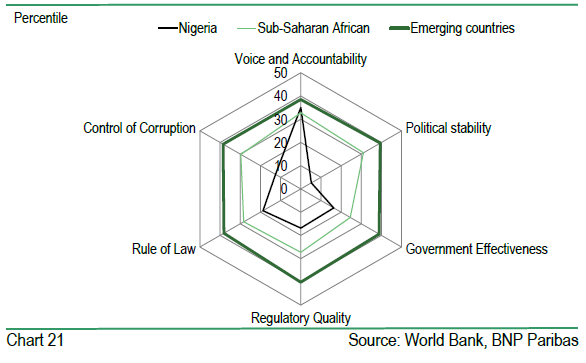The sub-Saharan Africa’s largest economy is having hard time to recover. External rebalancing has showed some progress. But imports remain well below pre-crisis levels. In addition, the rebuilding of FX reserves is being accompanied by increased financial vulnerability, which puts pressure on monetary policy as the authorities give the priority to exchange rate stability. Weak public finances are an additional constraint. In the short term, and despite its strong potential, the economy is expected to grow more slowly than the population. As well as improving macroeconomic stability, the authorities will have to address the deep-seated factors that are holding back the economy as a whole.
Nigeria is a long way from staging a full recovery from the 2014 oil shock. Although economic growth has recovered somewhat, it remains well below pre-crisis levels. Above all, forecasts show no significant improvement. There are various factors holding back the economy, including a tight monetary policy, weak public finances and external accounts, and deteriorating bank balance sheets. The ability of the authorities to addressing the underlying structural problems is also questionable.
Tepid economic recovery
According to the latest figures from Nigeria’s National Bureau of Statistics, economic growth slowed from 2.4% in Q42018 to 2% in Q12019 (Chart 1). This slowdown was not exclusively the result of poor performance in the hydrocarbon sector, where value added fell by 2.4%. Outside the hydrocarbon sector (91% of real GDP), growth also decelerated from 2.7% in the Q42018 to 2.5% in Q12019. This shows that the slowdown is not just a blip and illustrates the fragility of the economic recovery that has been taking place since real GDP contracted in 2016.
Economic growth

Ongoing headwinds
Nigeria’s recovery from recession in 2017 was initially driven by the rebound of oil production after some major acts of sabotage in the Niger Delta in 2016. Excluding the agriculture and hydrocarbon sectors, growth remained negative in 2017 (-0.6%) before recovering slightly in 2018 (+2%) due to firm momentum in the information and communication technologies (ICT) sector. Without the ICT sector, the picture would have been even gloomier, with real GDP growth of only 0.9% as opposed to 1.1% in 2017. The situation was similar in Q12019. Excluding ICT, which contributed for more than half of non-oil GDP growth (Chart 2), activity was at best sluggish (in the manufacturing, retail and real-estate sectors) and at worst continued to contract (finance and insurance). Even agricultural performance was disappointing, despite growth of 3.2% in Q1. Stronger growth was expected after a particularly tough 2018, when growth was 2.1% against 4.5% on average between 2010 and 2014.
Powerful headwinds remain. The agricultural sector is suffering from a number of conflicts in central and northern Nigeria, and whole swathes of the economy are continuing to be affected by restrictions imposed on around 40 products. Domestic demand is also depressed.
Contribution to non-oil GDP growth

Since 2014, real GDP per capita has fallen constantly. Weak non-oil growth combined with sustained rise in the labour force (+4.5%) has caused the unemployment rate to surge from 10% at the end of 2015 to 23% today, while a further 20% of the labour force is underemployed. In addition, inflation is persistently high (Chart 3): after falling between the end of 2017 and mid-2018 thanks to exchange rate stability, it has been around 11% since, propped up in particular by serious upward pressure on food prices (50.7% of the index).
Inflation

Finally, growth in bank lending to the private sector remained negative in late April 2019, in both real (inflation-adjusted) and nominal terms (Chart 4). Banks are highly exposed to the oil sector (30% of lending to the economy) and so have seen a sharp deterioration in their loan books (Chart 5). The non-performing loan ratio rose from 3% at the end of 2014 to 15% in mid-2017, before falling back to 11% in 2018 thanks to higher oil prices. According to the IMF, the large proportion of restructured loans could even mask a more deteriorated financing situation, and capitalisation ratio remain 3 points lower than its pre-crisis levels. Besides, high-yielding Treasury bonds are crowding out lending to the economy, and this is likely to continue in the near term.
Monetary Environment Still Tight
Nigeria’s monetary policy raises some questions. After more than two years of very tight monetary policy, the Central Bank of Nigeria (CBN) carried out a homeopathic cut in its policy rate from 14% to 13.5% in late March.
There are several factors that limited the extent of this move. The CBN mainly manages liquidity through large-scale issues of securities. As a result, interbank rates have been regularly above the key policy rate since 2015, diluting the signals it transmits (Chart 6), not to mention the high cost of such a policy (1.1% of GDP in 2018 alone according to the IMF). In addition, inflation is still above the monetary authorities’ target of 6-9%, and the risk is also on the upside in line with the decision to increase the minimum wage by two thirds (for both the private and public sectors), although the effects are hard to assess at this stage. Above all, the CBN is constrained by exchange-rate policy. To cushion the external shock resulting from the decline in oil export revenues, the monetary authorities initially devalued the naira’s official exchange rate by 30%, and then in April 2017 introduced a new window allowing investors and exporters to access foreign currency at rates set by market mechanisms.
Credit to the private sector

Soundness indicators of the banking system
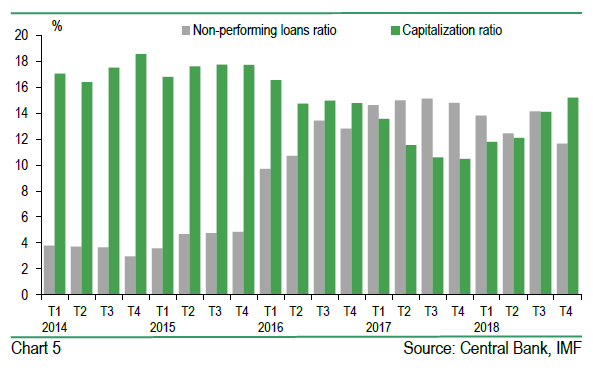
Interest rates
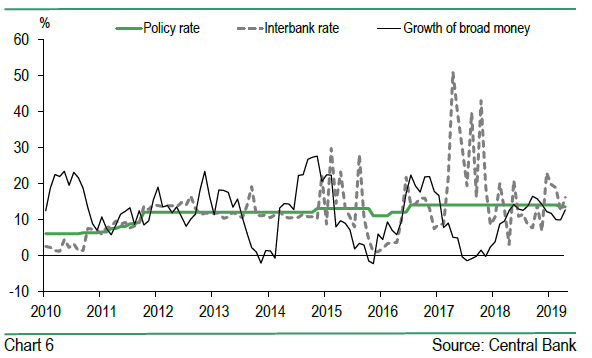
The NAFEX rate thus became the reference rate, moving into line with that of the parallel market (Chart 7). The gap between the NAFEX rate and the official exchange rate has narrowed to 20% after reaching a peak of 60% in February 2017. More than 70% of transactions are taking place through this window, at an exchange rate that has rapidly stabilised around NGN360 to the dollar. The official rate is NGN305 to the dollar and is mainly used for imports of petroleum products and external debt servicing.
Despite the distortions that creates, Nigeria’s president and the governor of the CBN are not in favour of seeing the two rates converge, because they believe this would push up inflation.
Exchange rates

Yet, both the current account as well as the structure of external financing remains fragile (see below). In particular, the CBN, by issuing huge amounts of securities to mop up liquidity in the last few years, has made Nigeria more vulnerable to capital flight. At the end of April, nonresident investors held the equivalent of USD 15 bn compared with a stock of FX reserves of USD 45 bn. As a result, Nigeria cannot allow yields on government bonds (including those issued by the CBN) to fall too sharply, since that could affect the stability of its exchange-rate regime. In other words, the scope for monetary easing will remain very limited.
Macroeconomic stability: Still fragile
With more than 90% of exports coming from the oil sector, Nigeria has experienced a large macroeconomic shock. External accounts fell into the red in 2015, leading to external liquidity shortages and so to the decision by the authorities to implement import restrictions. Since then, undeniable progress has been made.
Unlike other African oil-producing countries, Nigeria’s current account moved back into surplus in 2016 (Chart 8). Combined with significant capital inflows in 2017, Nigeria was able to rebuild FX reserves at comfortable levels. However, the balance of payments came under renewed pressure in 2018, showing how fragile the country’s external stability was. The authorities’ inability to increase non-oil revenue and soaring debt service costs also put public finances under strong pressure.
Current account

External Position: increased financial vulnerability
The improvement in Nigeria’s external accounts came to an abrupt halt in 2018. Despite firm oil exports, the current account surplus halved to USD 5 bn due to a surge in imports of services. With Nigeria being an importer of refined petroleum products, the increase in the global oil prices also pushed up goods imports by more than USD 3 bn.
A mega-refinery is under construction, and could be operational within 2-3 years. It should be able to cover the needs of the local market. Until then, oil imports will continue to represent the equivalent of 20% of oil exports.
Forex reserves

Moreover, Nigeria was also affected by massive capital outflows from April 2018 (USD 9 bn according to the IMF), the impact of which was partially offset by a new eurobond issue in November 2018 (USD 2.86 bn) following that of February (USD 2.5 bn). As a result, FX reserves shrank by 10% in the last nine months of the year, ending the year virtually flat after doubling October 2016 and end-2017.
Since then, the pressure has eased. FX reserves grew by almost USD 3 bn between January and May 2019, reaching USD 45 bn (Chart 9), fairly close to their all-time high. However, the overall picture remains mixed. Expressed in months of imports of goods and services, FX reserves have fallen from ten months in early 2018 to less than seven months of goods and services imports. Although that remains comfortable for dealing with a shock in the short term, large exposure to portfolio investments means that Nigeria will need a greater cushion to ensure its long-term external stability.
The pronounced decline in the global oil price, to USD 60.4, pushed the current account back into the red in Q12019 (Chart 10), barely a few months after a similar poor performance in Q32018 due to a surge of capital goods imports (linked to the construction of the new refinery). At this stage, we still see the current account remaining into a slight surplus of 1.0-1.5% in 2019 and 2020, provided that: 1/ global oil price stabilises at USD 65; 2/ imports do not exceed USD 40 bn, which supposes that protectionist policies adopted after the oil shock should be maintained. In 2014, imports of goods amounted to USD 61 bn.
External accounts and oil prices

Capital inflows
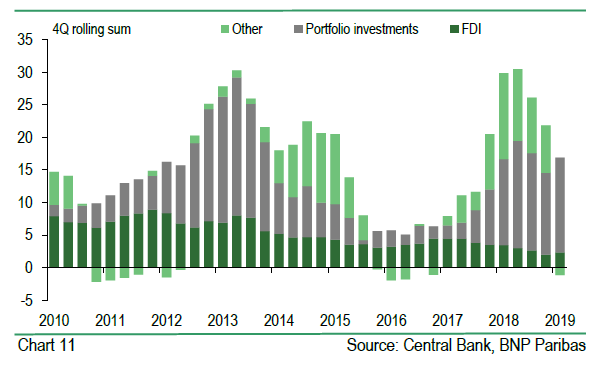
The external position relies on an increasingly volatile financing profile. Of the USD 7.6 bn of capital inflows in Q1 2019, USD 7.1 bn consisted of portfolio investments, of which 80% went into short-dated debt securities. This extremely high proportion of short-term capital inflows could be explained by tensions relating to the presidential election held in late February. However, portfolio flows have accounted for half of the surge in capital inflows in the last two years (Chart 11), while foreign direct investment has remained desperately low (0.7% of GDP on average). There is little reason for this to change in the near term, since financial conditions in Nigeria are sufficiently attractive for foreign investors looking for high yields. As a result, the stock “hot money”, already high (130% of FX reserves in Q1 2019, Chart 12), should continue to rise, making the country’s external position increasingly vulnerable to a downturn in investor confidence.
Indicator of external vulnerability

Public finances: Under Pressure
The fiscal situation is also difficult. Very low progress in improving tax collection is a particular source of concern. Having fallen to the historically low level of 5.6% of GDP in 2016, general government revenues have recovered since thanks to the upturn in oil prices. However, they only reached 8.7% of GDP in 2018, one of the lowest ratio in sub-Saharan Africa. More worrying still, non oil-related revenues fell to the exceptionally low level of 3.7% of GDP in 2018, down 0.4 points compared with 2015.
This is having various consequences. Firstly, it makes any prospect of a rapid of a rapid consolidation of public finances a distant possibility, even if oil prices remain stable. Budget deficit, which narrowed slightly to 4.9% of GDP in 2018 after peaking at 5.3% in 2017, is set to remain above 4% this year and in 2020 (Chart 13), twice the ratio seen in 2014. Secondly, the government has very little room for manoeuvre. Unsurprisingly, Nigeria’s public spending expressed in % of GDP is also among the lowest in sub-Saharan Africa (Chart 14). In particular, public investment was estimated to be 3.3% of GDP in 2018, 1 point lower on average than others African oil-producing countries, even though they are also subject to major fiscal constraints.
Low domestic revenues also weigh on the state’s creditworthiness. The widening budget deficit since 2014 has caused public debt to rise rapidly. Although public debt remained moderate relative to GDP at 22.4% in 2018, it represented 2.5 times the government’s revenue. Most importantly, debt has become much more expensive since 2014 because of rising interest rates in the domestic market. Interest payments now absorb more than 20% of the government revenue, up from 9% in 2014 (Chart 15). The government is trying to get around the problem by borrowing more on the international financial markets. The goal is to increase the share of debt denominated in foreign currencies to 40% from 32% today.
Budget balance

Government expenditure

This seems to be a coherent strategy but it’s not without risk as it exposes public finances to exchange rate risk. Public debt denominated in foreign currencies is low, below 6% of GDP, and refinancing risk is moderate because the first large repayments of principal on its eurobonds are not due until 2025. In addition, with a spread of 500 basis points (in line with other African issuers), financing conditions should remain more favourable than in the domestic market.
Although interest rates have fallen since non-resident investors returned to the local debt market, yields on short-dated Treasury bills are still between 12% and 14% (Chart 16). The need to defend the peg, high inflation and the government’s large borrowing requirement (20% of domestic debt consists of Treasury bills) suggest that interest rates will not fall far from their current level. With interest payments likely to continue absorbing more than 20% of the budget in 2019 and 2020, Nigeria will continue to have limited fiscal leeway to face any new setbacks.
General government debt

Treasury bond yield

Medium-term outlook: remove structural constraints
How long will it take for Nigeria to get growth back to its pre-crisis level? The country has undeniable potential. Despite the difficulties of the last few years, Nigeria remains Africa’s largest economy with GDP of USD 435 bn.
According to the UN, its population is likely to more than double to 410 million between now and 2050, with 70% of people expected to live in urban areas against 50% today. That would make Nigeria the world’s third most populous country. However, given that its socio-economic needs are already huge – GDP per capita is only USD 2,000 – these demographic trends could be seen as either a threat or a huge investment opportunity. At the moment, pessimism is prevailing. With economic growth set to recover only slightly to 2.5% in 2020 before stabilising, real GDP per-capita will continue to contract (Chart 17), underlying the urgent need to tackle the many structural constraints that are hampering the economy.
Economic growth

Hydrocarbon Sector
At first sight, Nigeria’s oil industry is performing fairly well. Production has risen back almost to 2 million barrels per day (bpd) after falling to 1.8 million in 2016 because of sabotage. In addition, production has just started at the huge Egina oilfield, which is expected to add some 200,000 bpd (ie 10% of Nigeria’s total production). However, Nigeria could be doing much better taking into account its huge reserves (a third of Africa’s total) and the maturity of its oil industry, where international oil companies have been operating since 1950.
Oil production

Oil production is expected to amount to 2.1 million bpd in 2020 (Chart 18), still well below the peak levels seen in 2005 and 2010. Ongoing security problems in the Niger Delta area remain one of the main factors holding back the oil industry’s development. To overcome these problems, international oil companies have turned their attention to deepwater offshore reserves, but high production costs and uncertainties about regulatory reform are reducing their attractiveness.
The reform process is complex and has been going on for more than a decade. It includes notably tax reforms, the restructuring of the national oil company NNPC and the role of the Nigerian state as shareholder. In particular, the state is apparently seeking to reduce its interest in its oil joint ventures with foreign companies to 40% by the end of 2019, as opposed to 55-60% today. However, the current context is not helpful for this kind of initiative. Above all, president Buhari showed little interest in reorganising the oil sector during his first term of office, which does not suggest that major changes lie ahead.
Non Hyrocarbon Sector
Reforms are not just crucial for the future of the oil industry, but also for the rest of Nigeria’s economy if not more so.
The economy is facing huge challenges. Various business-climate surveys rank Nigeria as one of the world’s most difficult countries to do business. For example, the World Bank’s survey puts Nigeria 146th out of 190 countries. In addition, the overall ranking must be kept into perspective.
Investment rate

Although Nigeria’s position has risen more than 20 places in the last three years, it is only in line with the average for sub-Saharan Africa, which is well below international standards. In addition, Nigeria’s progress has resulted mainly from efforts to simplify regulatory procedures, not an improvement in infrastructure, which remains a real obstacle to the development of the private sector. Power generation is particularly lacking. Nigeria has a total capacity of 12,500 MW for a country of 190 million inhabitants, and needs virtually double that capacity. Most importantly, power generation can fall below 4,000 MW because of limited grid capacity, forcing corporates and individuals to resort to more costly alternative systems. The additional costs arising from the lack of physical (ports and roads) and health infrastructures are also significant. It is therefore not surprising that Nigeria shows entrenched low levels of investment.
The situation has even worsened in the last few years due to rising risk aversion of banks, subdued economic growth and strong pressure on public finances. In 2018, gross investment was below 14% of GDP, down from 16% in 2014 (Chart 19). By comparison, the average for other African oil-producing countries was 23% and 25% for sub- Saharan Africa. Nigeria is also finding it increasingly difficult to attract foreign direct investment (Chart 20). In 2018, it received less FDI than Ghana, despite its GDP being six times larger. FDI into Nigeria is also concentrated mainly on the hydrocarbon sector, with limited knock-on benefits for the rest of the economy.
Governance is another stumbling block. If reforms should stimulate investment, they also need to be executed properly. However, Nigeria’s ranking in terms of the World Bank’s governance indicators (Chart 21) shows that it has a long way to go in this area.
The 2014 oil shock seems to have caused long-term damage in Nigeria. Although access to foreign exchange access has improved, macroeconomic conditions are not currently allowing the economic growth to get back on track in a meaningful way.
On positive side, the re-election of president Buhari has removed a major source of uncertainty. His clear victory in the first round of the election and the firm grip of the ruling party, APC, on the National Assembly and the Senate give him the necessary leeway to go ahead with reforms included in the Economic Recovery and Growth Plan (ERPG 2017-2020). The overview of the economic situation that the plan describes is shared by main international organisations. Upgrading Nigeria’s infrastructure, particularly energy infrastructure, developing sectoral policies aimed at speeding up the diversification of the economy, and revitalising the oil industry are among the main priorities.
However, to translate good intentions into action, a greater cohesion between the various levels of the power will be necessary in order to overcome Nigeria’s long-standing challenges amid a weak international climate and a strong financial constraint.
Foreign direct investment
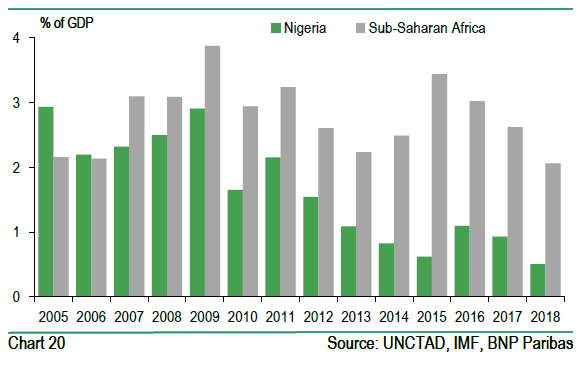
Governance indicators
